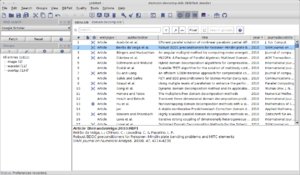JabRef
| JabRef
|
|
|---|---|
|
|
|
 JabRef on Linux |
|
| Basic data
|
|
| developer | Oliver Kopp, Jörg Lenhard, Stefan Kolb, Matthias Geiger, Tobias Diez, Christoph Schwentker, Linus Dietz, Carl Christian Snethlage |
| Publishing year | November 29, 2003 |
| Current version |
5.0 ( March 10, 2020 ) |
| operating system | Platform independent |
| programming language | Java |
| category | Literature management program |
| License | from version 3.6: MIT License , before: GPL |
| German speaking | Yes |
| www.jabref.org | |
JabRef is a free literature management program that uses the BibTeX format, which is the standard format for literature databases for LaTeX . The application is programmed in Java and is maintained for Windows , Linux and macOS . JabRef offers an interface for editing BibTeX files, for importing data from scientific online databases and for managing and searching in BibTeX files. The program was originally released under the GPL ; for version 3.6 they switched to the MIT license .
history
The first version of JabRef was published on Sourceforge in 2003 after the authors of BibKeeper (Morten O. Alver) and JBibtexManager (Nizar Batada) decided to merge their projects. Since then, the program has been continuously developed and its range of functions expanded.
In the 2015/2016 winter semester and 2016 summer semester, JabRef version 3 was upgraded to Java 8 as part of a study project at the University of Stuttgart and a migration to JavaFX was prepared. The switch to JavaFX was completed in version 4.
Range of functions
With JabRef literature databases can be created, organized, searched and exported. In contrast to comparable applications, JabRef saves literature data in BibTeX files. Both the BibTeX and BibLaTeX standards can be used. BibTeX files can be opened and edited with any text editor and are very readable compared to other bibliographic data formats .
Reading lists can be searched and edited in JabRef. Entries can be assigned to keywords (groups) both manually and automatically (also using regular expressions ) and the keywords can be organized hierarchically. Keywords can be combined with logical AND or OR in order to display intersections or combinations of keywords. This also makes it possible, for example, to implement facet classifications .
The entry of bibliographic data is possible manually via an input mask or automatically via interfaces. The input masks for various types of literature (monographs, articles, etc.) can be adapted by the user. It is also possible to create non-standardized literature types. Filters are currently available for 15 bibliographic data formats for the automatic import of bibliographic data (including EndNote , MEDLINE , RIS , SciFinder). BibTeX is offered as an exchange format by numerous library catalogs. In addition, the direct search and download of data from PubMed , IEEE Xplore and CiteSeer are offered. With the JabRef Browser Extension, bibliographic information from websites can be imported directly into JabRef.
Full texts can also be searched for and managed. Links to external resources (local files, URL , DOI ) are inserted via text input, drag-and-drop or menu entry and opened from the literature list with a click of the mouse. When inserting PDF files, bibliographic metadata can be read out or later written into the PDF document. Newer versions also support the reading of annotations from PDF documents. Recommended reading can be found on the Mr. DLib service. MathSciNet is integrated.
Reading lists can be exported in a number of standard formats ( DocBook , HTML , Office Open XML, or OpenOffice.org ). You can also create your own export filters. For common word processing programs there is the possibility to transfer literature entries from JabRef directly into the edited document.
It can also be used for batch processing in command line interpreters or scripts for converting files with literature references.
Web links
Individual evidence
- ↑ DEVELOPERS on the JabRef GitHub page
- ↑ Release 5.0 . March 10, 2020 (accessed March 11, 2020).
- ^ Frank Mittelbach, Michel Goossens a. a .: The LaTeX companion . 2., revised. and exp. Ed. Pearson Studium, Munich [a. a.] 2005, ISBN 3-8273-7166-X , pp. 819 .
- ↑ Oliver Kopp: Towards JabRef 3. In: Mailing list JabRef Users. June 30, 2015, accessed June 22, 2016 .
- ↑ a b JabRef Developers: October 04, 2017 - JabRef 4.0. October 4, 2017, accessed October 5, 2017 .